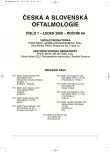-
Medical journals
- Career
Posterior Capsule Opacification following the Implantation of Various Types of IOLs – Part II. Different Intraoperative Findings
Authors: P. Krajčová; M. Chynoranský; P. Strmeň
Authors‘ workplace: Klinika oftalmológie LF UK a FNsP, Bratislava, prednosta prof. MUDr. P. Strmeň, CSc.
Published in: Čes. a slov. Oftal., 64, 2008, No. 1, p. 13-15
Overview
Purpose:
The posterior capsule opacification (PCO) is the most frequent complication of uncomplicated extracapsular cataract extraction (ECCE). It is caused by incompletely removed epithelial cells of the original lens capsule, which proliferate and migrate along the internal anterior and posterior surface of capsule. Clinically, the PCO manifests as blurred vision and decrease of visual acuity. Opacification of the initially transparent posterior capsule occurs in patients who underwent the ECCE at variable time after surgery. According to the currently published results, the incidence of PCO varies from 10 to 40 %, 3 to 5 years after the cataract surgery (3, 4). In patients with certain types of IOLs (sharp-edged IOLs), the PCO rate has been reported as low as 5 % (2).
The anterior eye segment analyzing system is a device designed to measure the degree of PCO objectively and thus to compare the various types of IOLs, various surgical techniques and their effect on the PCO development, independently on the patient’s visual acuity. The aim of the study proposed is to assess PCO development in patients operated on at the Department of Ophthalmology of Faculty Hospital Bratislava, Slovakia, EU, by means of the EAS 1000 machine (NIDEK).Materials and methods:
The aim of this prospective study was to evaluate the PCO development following the implantation of various IOLs types based on the measurement of the eyes of patients operated on at our department. PCO assessment was performed by EAS 1000 on day 1, day 7, and 3, 6, 12, 24, and 36 months after the cataract surgery.
Capsules of patients with various intraoperative findings were compared in the study. The first (and largest) group consisted of patients with no postoperative fibrosis and no perioperative complications (I. part). The second and third groups included patients with the intraoperative findings of posterior capsule fibrosis and patients with previous eye surgery, respectively.Results:
No significant drop of posterior capsule transparency was detected following the implantation of various types of intraocular lenses. In the group of eyes compromised by previous surgery, the comparison was possible to be made on the first postoperative day only, yet with an insignificant result.Conclusion:
Anterior eye segment analyzer EAS 1000 (NIDEK) allows objective evaluation of posterior lens capsule transparency using the digital retro-illumination photography. It appears that not all posterior capsule findings in eyes with intraocular lenses are suitable for such objective analysis.Key words:
posterior capsule opacification, intraocular lens, eye analyzing system EAS 1000, polymethylmetacrylate, hydrophilic acrylate, complications
Sources
1. Buchl, W., Findl, O., Menapace, R. et al.: Reproducibility of standardized retroilumination photography for quantification posterior capsule opacification, J. Cataract Refract. Surg., 28, 2002 : 265 – 270.
2. Hayashi, K., Hayashi H.: Posterior capsule opacification in the presence of an intraocular lens with a sharp versus rounded optic edge, Ophthalmology, 112, 2005 : 1550 – 1556.
3. Pandey, S.K., Apple, D.J., Werner, L. et al.: Posterior capsule opacification: A review of the ethiopathogenesis, Experimental and clinical studies and factors for prevention, Ophthalmol., 52, 2004 : 99-112.
4. Schaumberg, D.A., Dana, M.R., Christen, W.G. et al.: A systemic overview of the incidence of posterior capsule opacification, Ophthalmology, 105, 1998 : 1213-1221.
5. Tetz, M. R., Nimsgern, Ch.: Posterior capsule opacification: Part 2: Clinical findings, review, J. Cataract Refract. Surg., 25, 1999 : 1662-1674.
Labels
Ophthalmology
Article was published inCzech and Slovak Ophthalmology

2008 Issue 1-
All articles in this issue
- Long - Term Results of the Postoperative Ametropia Correction after Perforating Keratoplasty Using the LASIK Method
- Posterior Capsule Opacification following the Implantation of Various Types of IOLs – Part II. Different Intraoperative Findings
- Comparison of Contact and Immersion Techniques of Ultrasound Biometry
- Primary Vitrectomy with Intravitreal Antibiotic Application in Postoperative and Posttraumatic Endophthalmitis
- Resorption of the Diabetic Cystoid Macular Edema after Intravitreal Triamcinolon Acetonide Injection Depending on Compensation of Diabetes and Systemic Hypertension
- Malignant Melanoma of the Uvea in the Department of Ophthalmology, Faculty Hospital Brno Bohunice, Czech Republic, EU
- Sarcoidosis – a Case Report
- Czech and Slovak Ophthalmology
- Journal archive
- Current issue
- Online only
- About the journal
Most read in this issue- Sarcoidosis – a Case Report
- Malignant Melanoma of the Uvea in the Department of Ophthalmology, Faculty Hospital Brno Bohunice, Czech Republic, EU
- Comparison of Contact and Immersion Techniques of Ultrasound Biometry
- Primary Vitrectomy with Intravitreal Antibiotic Application in Postoperative and Posttraumatic Endophthalmitis
Login#ADS_BOTTOM_SCRIPTS#Forgotten passwordEnter the email address that you registered with. We will send you instructions on how to set a new password.
- Career

